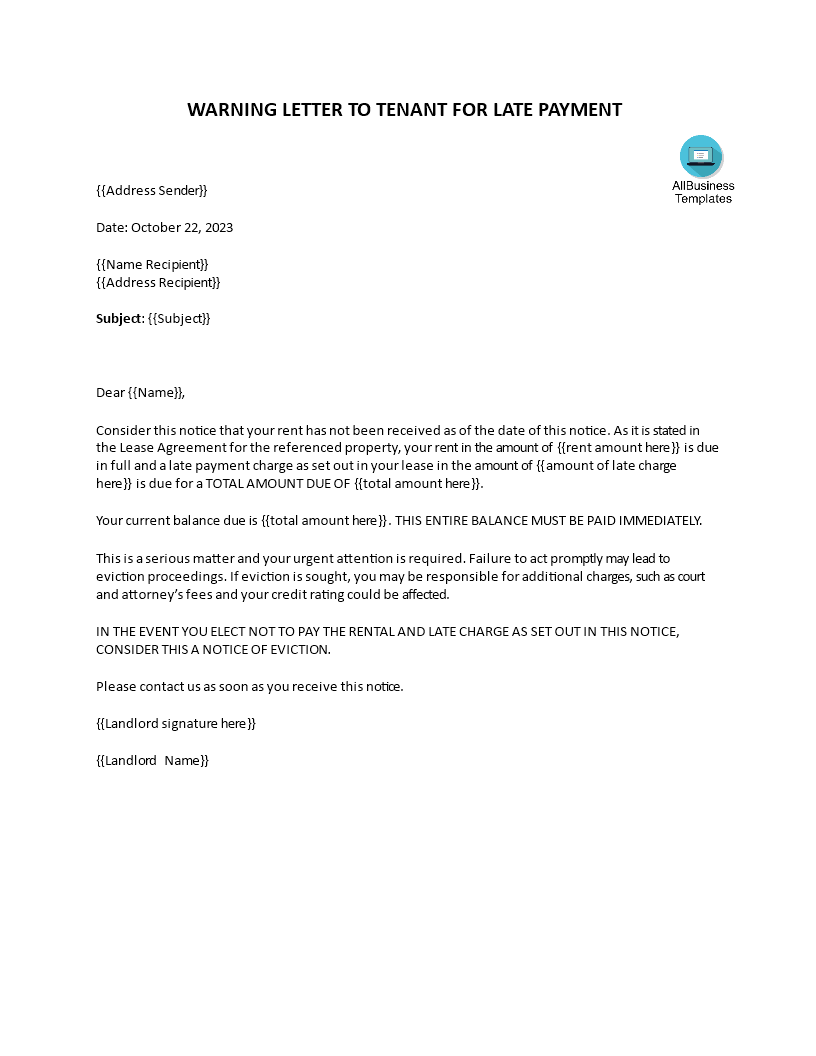Warning Letter To Tenant For Late Payment
Save, fill-In The Blanks, Print, Done!

Download Warning Letter To Tenant For Late Payment
Microsoft Word (.docx)Or select the format you want and we convert it for you for free:
- This Document Has Been Certified by a Professional
- 100% customizable
- This is a digital download (22.93 kB)
- Language: English
- We recommend downloading this file onto your computer.
How to create a warning letter to a tenant for late payment? Do you need a warning letter template to send to a tenant for late payments? You can use this template as a guide for creating your own warning letter to the tenant for late payment. Make sure to include the due date for payment of the rent and a clear warning of the consequences of not paying on time. Download this real estate Warning Letter To Tenant For Late Payment template now!
A warning letter to a tenant is a formal written notice issued by a landlord or property manager to inform a tenant of their violations of the terms and conditions of their lease agreement. This type of letter serves as a documented warning, outlining the specific lease violations, the actions required to remedy the situation, and the consequences if the tenant fails to rectify the issues. Warning letters to tenants are typically a precursor to more serious actions such as eviction if the tenant does not address the problems.
Here's how to write a warning letter to a tenant:
1. Your Contact Information:
- Include your name, address, phone number, and email address at the top of the letter.
2. Date:
- Include the date when you are writing the letter.
3. Tenant's Contact Information:
Add the tenant's name, address, and any other relevant contact details.
4. Salutation:
- Start the letter with a formal greeting, such as "Dear [Tenant's Name]."
5. Opening Paragraph:
- In the first paragraph, clearly state the purpose of the letter, which is to address lease violations and issue a warning. For example, "I am writing to inform you of several lease violations and to provide a formal warning regarding these issues."
6. Detail Lease Violations:
- List the specific lease violations that the tenant has committed. Be clear and concise, providing details and dates for each violation. For example, if the tenant has been consistently late with rent payments, specify the number of times and the amounts.
7. Consequences of Non-Compliance:
- Clearly state the consequences the tenant may face if they do not address and rectify the violations. Common consequences may include eviction, legal action, or the termination of the lease agreement.
8. Required Actions:
- Specify the actions the tenant needs to take to remedy the violations. For example, if the violation is related to cleanliness, you might request that the tenant clean up their unit within a specified time frame.
9. Deadline:
- Set a specific deadline by which the tenant must correct the violations. This deadline should be reasonable and in compliance with local and state laws.
10. Contact Information:
- Provide your contact information in case the tenant has questions or needs to discuss the matter.
11. Closing:
- Conclude the letter with a polite closing, such as "Sincerely" or "Yours sincerely."
12. Signature:
- Sign the letter if sending a printed copy. If it's an electronic document, type your name.
13. Copies:
- If required by local laws or your lease agreement, send copies of the warning letter to relevant authorities, such as a housing authority or legal counsel.
14. Keep a Copy:
- Retain a copy of the warning letter for your records.
It's essential that a warning letter to a tenant is professionally written, clear, and compliant with local landlord-tenant laws and the terms of the lease agreement. Always keep a copy for your records, and be prepared to take further action if the tenant does not comply with the warning. Consult with legal counsel if necessary to ensure that your actions are in accordance with local regulations.
DISCLAIMER
Nothing on this site shall be considered legal advice and no attorney-client relationship is established.
Leave a Reply. If you have any questions or remarks, feel free to post them below.
Related templates
Latest templates
Latest topics
- Formal Complaint Letter of Harrasment
How do I write a formal complaint about harassment? Check out these formal complaint letter of harrasment templates here! - Google Sheets Templates
How to work with Google Sheets templates? Where to download useful Google Sheets templates? Check out our samples here. - Letter Format
How to format a letter? Here is a brief overview of common letter formats and templates in USA and UK and get inspirited immediately! - IT Security Standards Kit
What are IT Security Standards? Check out our collection of this newly updated IT Security Kit Standard templates, including policies, controls, processes, checklists, procedures and other documents. - Excel Templates
Where do I find templates for Excel? How do I create a template in Excel? Check these editable and printable Excel Templates and download them directly!
cheese

